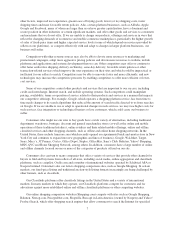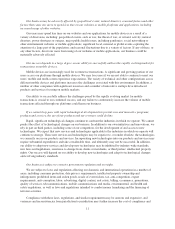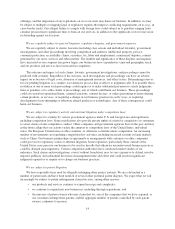eBay 2015 Annual Report Download - page 19
Download and view the complete annual report
Please find page 19 of the 2015 eBay annual report below. You can navigate through the pages in the report by either clicking on the pages listed below, or by using the keyword search tool below to find specific information within the annual report.other factors, improved user experience, greater ease of buying goods, lower (or no) shipping costs, faster
shipping times and more favorable return policies. Also, certain platform businesses, such as Alibaba, Apple,
Google and Facebook, many of whom are larger than us or have greater capitalization, have a dominant and
secure position in other industries or certain significant markets, and offer other goods and services to consumers
and merchants that we do not offer. If we are unable to change our products, offerings and services in ways that
reflect the changing demands of ecommerce and mobile commerce marketplaces, particularly the higher growth
of sales of fixed-price items and higher expected service levels (some of which depend on services provided by
sellers on our platforms), or compete effectively with and adapt to changes in larger platform businesses, our
business will suffer.
Competitors with other revenue sources may also be able to devote more resources to marketing and
promotional campaigns, adopt more aggressive pricing policies and devote more resources to website, mobile
platforms and applications and systems development than we can. Other competitors may offer or continue to
offer faster and/or free shipping, delivery on Sunday, same-day delivery, favorable return policies or other
transaction-related services which improve the user experience on their sites and which could be impractical or
inefficient for our sellers to match. Competitors may be able to innovate faster and more efficiently, and new
technologies may increase the competitive pressures by enabling competitors to offer more efficient or lower-
cost services.
Some of our competitors control other products and services that are important to our success, including
credit card interchange, Internet search, and mobile operating systems. Such competitors could manipulate
pricing, availability, terms or operation of service related to their products and services in a manner that impacts
our competitive offerings. For example, Google, which operates a shopping platform service, has from time to
time made changes to its search algorithms that reduced the amount of search traffic directed to us from searches
on Google. If we are unable to use or adapt to operational changes in such services, we may face higher costs for
such services, face integration or technological barriers or lose customers, which could cause our business to
suffer.
Consumers who might use our sites to buy goods have a wide variety of alternatives, including traditional
department, warehouse, boutique, discount and general merchandise stores (as well as the online and mobile
operations of these traditional retailers), online retailers and their related mobile offerings, online and offline
classified services and other shopping channels, such as offline and online home shopping networks. In the
United States, these include Amazon.com (which recently opened an experimental brick-and-mortar store in New
York City and continues to expand into new geographies and lines of business), Google, Wal-Mart, Target,
Sears, Macy’s, JC Penney, Costco, Office Depot, Staples, OfficeMax, Sam’s Club, Rakuten, Yahoo! Shopping,
MSN, QVC and Home Shopping Network, among others. In addition, consumers have a large number of online
and offline channels focused on one or more of the categories of products offered on our site.
Consumers also can turn to many companies that offer a variety of services that provide other channels for
buyers to find and buy items from sellers of all sizes, including social media, online aggregation and classifieds
platforms, such as craigslist, Oodle.com and a number of international websites operated by Schibsted ASA or
Naspers Limited. Consumers also can turn to shopping-comparison sites, such as Google Shopping. In certain
markets, our fixed-price listing and traditional auction-style listing formats increasingly are being challenged by
other formats, such as classifieds.
Our Classifieds platforms offer classifieds listings in the United States and a variety of international
markets. In many markets in which they operate, our Classifieds platforms compete for customers and for
advertisers against more established online and offline classifieds platforms or other competing websites.
Our online shopping comparison websites (Shopping.com) compete with sites such as Google Shopping,
Rakuten, Nextag.com, Pricegrabber.com, Shopzilla, Buscapé in Latin America (owned by Naspers) and Yahoo!
Product Search, which offer shopping search engines that allow consumers to search the Internet for specified
7
























